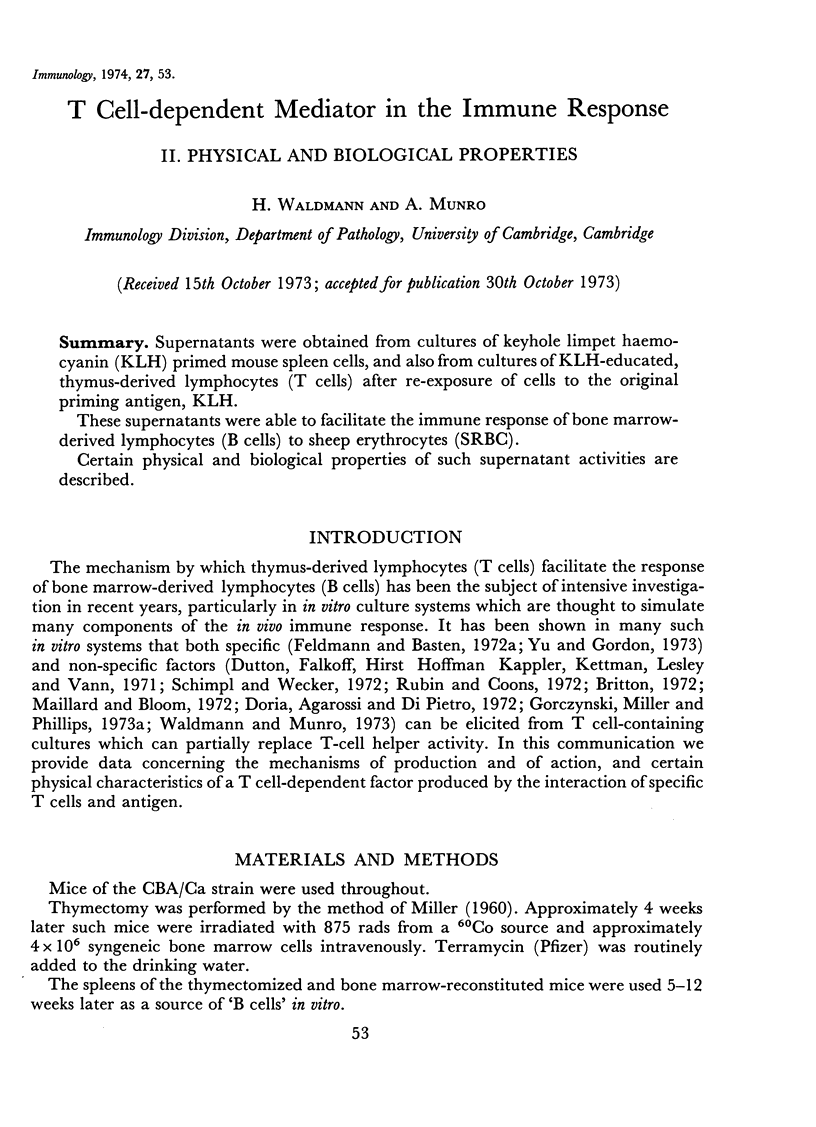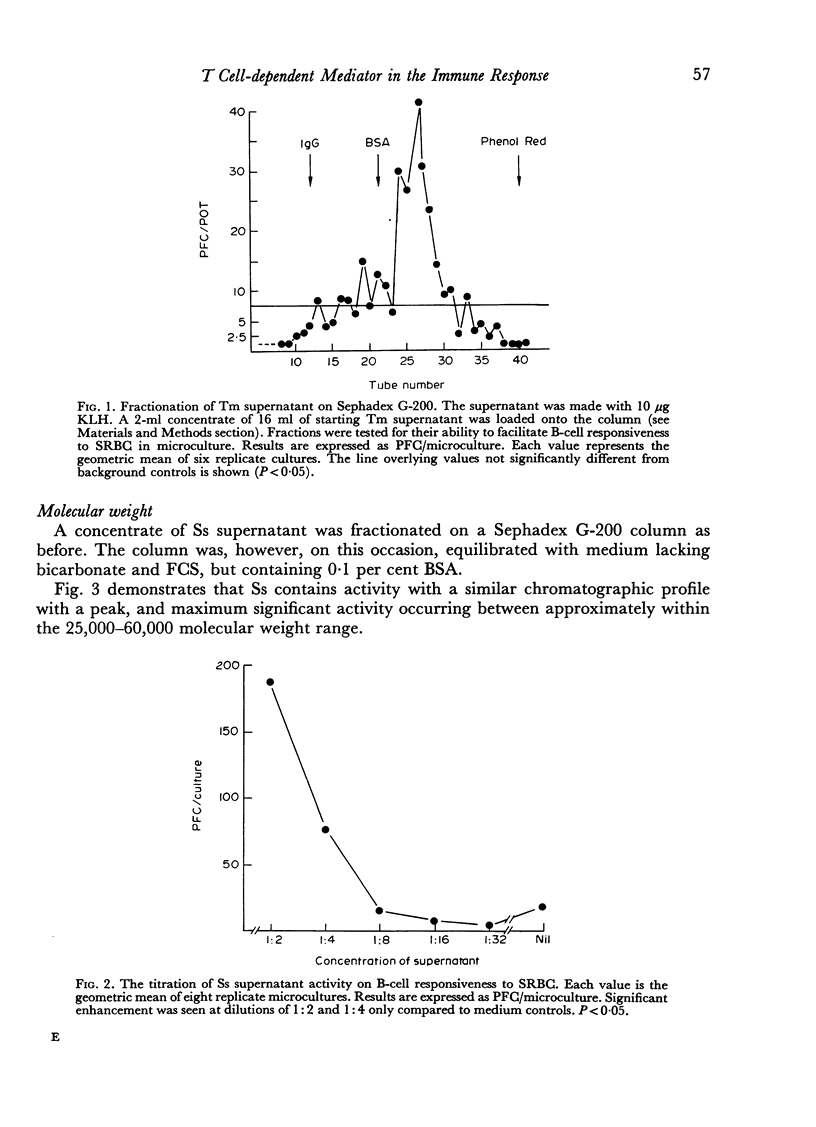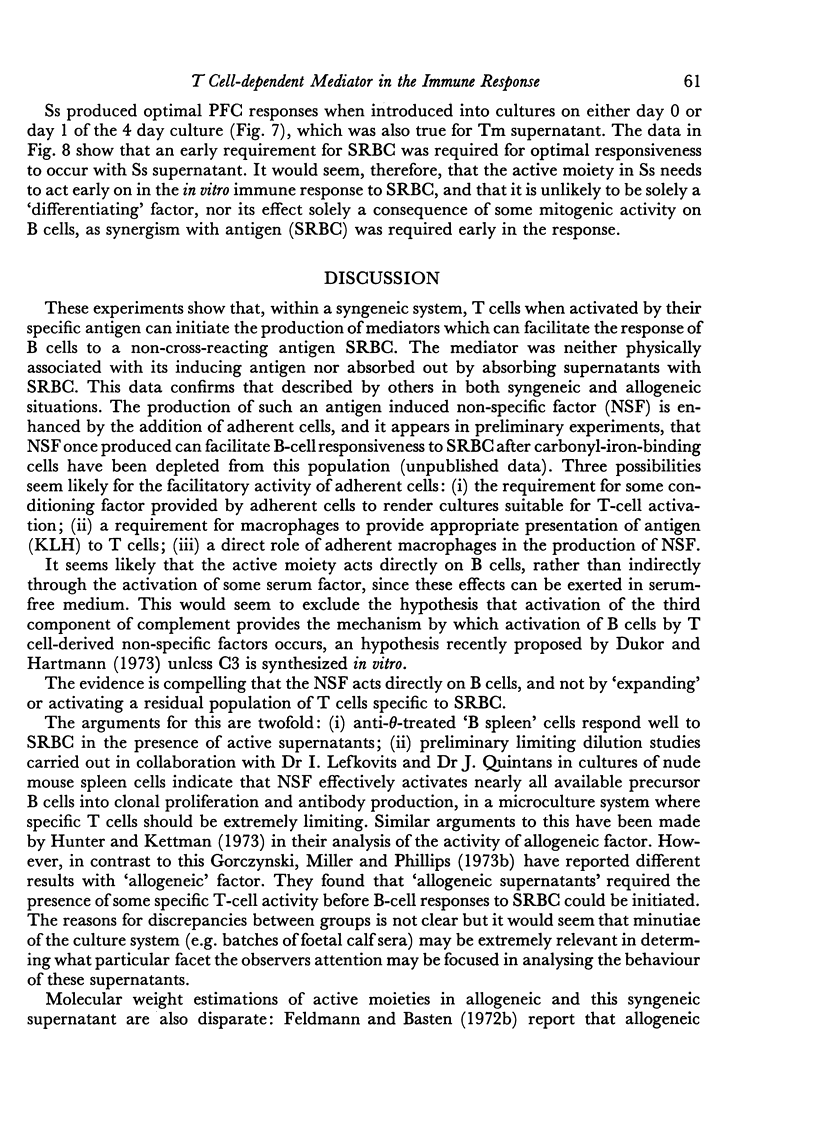Abstract
Supernatants were obtained from cultures of keyhole limpet haemocyanin (KLH) primed mouse spleen cells, and also from cultures of KLH-educated, thymus-derived lymphocytes (T cells) after re-exposure of cells to the original priming antigen, KLH.
These supernatants were able to facilitate the immune response of bone marrow-derived lymphocytes (B cells) to sheep erythrocytes (SRBC).
Certain physical and biological properties of such supernatant activities are described.
Full text
PDF











Selected References
These references are in PubMed. This may not be the complete list of references from this article.
- Britton S. When allogeneic mouse spleen cells are mixed in vitro the T-cells secrete a product which guides the maturation of B-cells. Scand J Immunol. 1972;1(1):89–98. doi: 10.1111/j.1365-3083.1972.tb03738.x. [DOI] [PubMed] [Google Scholar]
- Click R. E., Benck L., Alter B. J. Immune responses in vitro. I. Culture conditions for antibody synthesis. Cell Immunol. 1972 Feb;3(2):264–276. doi: 10.1016/0008-8749(72)90165-7. [DOI] [PubMed] [Google Scholar]
- Doria G., Agarossi G., Di Pietro S. Enhancing activity of thymocyte culture cell-free medium on the in vitro immune response of spleen cells from neonatally thymectomized mice to sheep RBC. J Immunol. 1972 Jan;108(1):268–270. [PubMed] [Google Scholar]
- Dukor P., Hartmann K. U. Hypothesis. Bound C3 as the second signal for B-cell activation. Cell Immunol. 1973 Jun;7(3):349–356. doi: 10.1016/0008-8749(73)90199-8. [DOI] [PubMed] [Google Scholar]
- Feldmann M., Basten A. Cell interactions in the immune response in vitro. IV. Comparison of the effects of antigen-specific and allogeneic thymus-derived cell factors. J Exp Med. 1972 Oct 1;136(4):722–736. doi: 10.1084/jem.136.4.722. [DOI] [PMC free article] [PubMed] [Google Scholar]
- Feldmann M., Nossal G. J. Tolerance, enhancement and the regulation of interactions between T cells, B cells and macrophages. Transplant Rev. 1972;13:3–34. doi: 10.1111/j.1600-065x.1972.tb00058.x. [DOI] [PubMed] [Google Scholar]
- Gorczynski R. M., Miller R. G., Phillips R. A. Reconstitution of T cell-depleted spleen cell populations by factors derived from T cells. 3. Mechanism of action of T cell-derived factors. J Immunol. 1973 Sep;111(3):900–913. [PubMed] [Google Scholar]
- Katz D. H., Paul W. E., Goidl E. A., Benacerraf B. Carrier function in anti-hapten antibody responses. 3. Stimulation of antibody synthesis and facilitation of hapten-specific secondary antibody responses by graft-versus-host reactions. J Exp Med. 1971 Feb 1;133(2):169–186. doi: 10.1084/jem.133.2.169. [DOI] [PMC free article] [PubMed] [Google Scholar]
- MILLER J. F. Studies on mouse leukaemia. The role of the thymus in leukaemogenesis by cell-free leukaemic filtrates. Br J Cancer. 1960 Mar;14:93–98. doi: 10.1038/bjc.1960.11. [DOI] [PMC free article] [PubMed] [Google Scholar]
- Maillard J., Bloom B. R. Immunological adjuvants and the mechanism of cell cooperation. J Exp Med. 1972 Jul 1;136(1):185–190. doi: 10.1084/jem.136.1.185. [DOI] [PMC free article] [PubMed] [Google Scholar]
- Mishell R. I., Dutton R. W. Immunization of dissociated spleen cell cultures from normal mice. J Exp Med. 1967 Sep 1;126(3):423–442. doi: 10.1084/jem.126.3.423. [DOI] [PMC free article] [PubMed] [Google Scholar]
- Mond J. J., Takahashi T., Thorbecke G. J. Thymus-derived cell (T cell) activation by heterologous antigens as a replacement of specific immune T cells in the transfer of the secondary response to sheep erythrocytes. J Exp Med. 1972 Oct 1;136(4):715–721. doi: 10.1084/jem.136.4.715. [DOI] [PMC free article] [PubMed] [Google Scholar]
- Mosier D. E. A requirement for two cell types for antibody formation in vitro. Science. 1967 Dec 22;158(3808):1573–1575. doi: 10.1126/science.158.3808.1573. [DOI] [PubMed] [Google Scholar]
- Rajewsky K., Roelants G. E., Askonas B. A. Carrier specificity and the allogeneic effect in mice. Eur J Immunol. 1972 Dec;2(6):592–598. doi: 10.1002/eji.1830020622. [DOI] [PubMed] [Google Scholar]
- Rubin A. S., Coons A. H. Specific heterologous enhancement of immune responses. 3. Partial characterization of supernatant material with enhancing activity. J Immunol. 1972 Jun;108(6):1597–1604. [PubMed] [Google Scholar]
- Shortman K., Palmer J. The requirement for macrophages in the in vitro immune response. Cell Immunol. 1971 Oct;2(5):399–410. doi: 10.1016/0008-8749(71)90051-7. [DOI] [PubMed] [Google Scholar]
- Sjöberg O., Andersson J., Möller G. Reconstitution of the antibody response in vitro of T cell-deprived spleen cells by supernatants from spleen cell cultures. J Immunol. 1972 Dec;109(6):1379–1385. [PubMed] [Google Scholar]
- Waldmann H., Munro A. Letter: T cell-dependent mediator in the immune response. Nature. 1973 Jun 8;243(5406):356–357. doi: 10.1038/243356a0. [DOI] [PubMed] [Google Scholar]
- Wu C., Cinader B. Antigenic promotion. Increase in hapten-specific plaque-forming cells after pre-injection with structurally unrelated macromolecules. J Exp Med. 1971 Sep 1;134(3 Pt 1):693–712. doi: 10.1084/jem.134.3.693. [DOI] [PMC free article] [PubMed] [Google Scholar]


